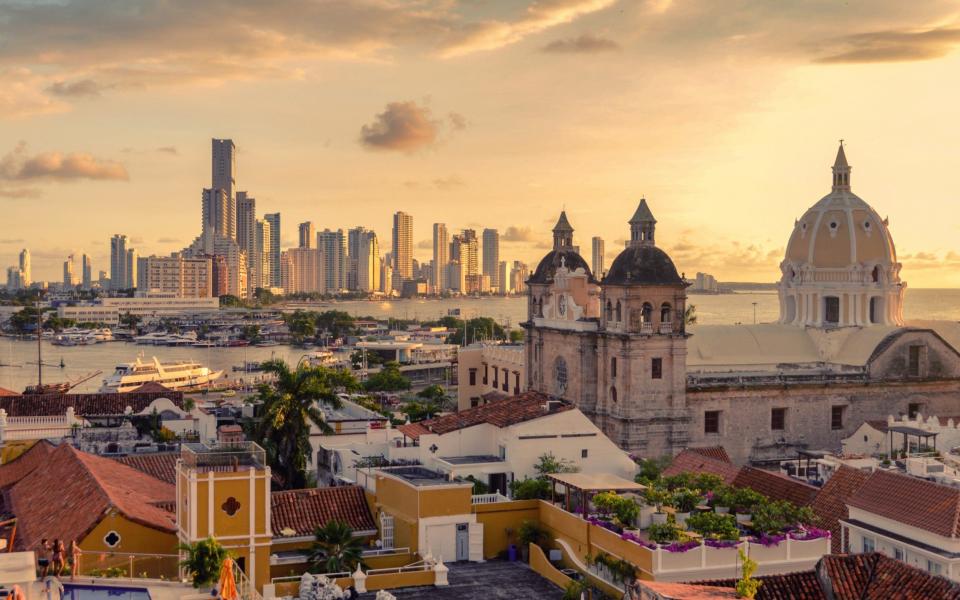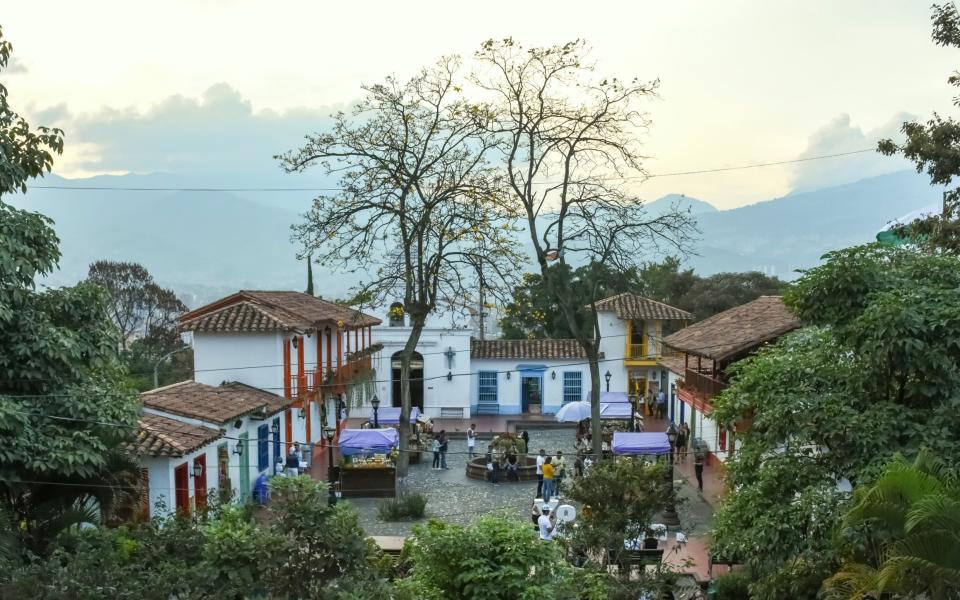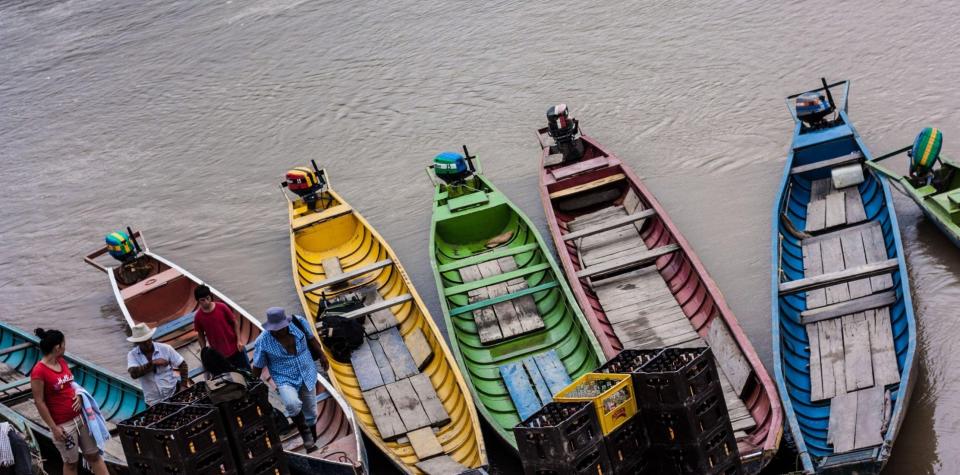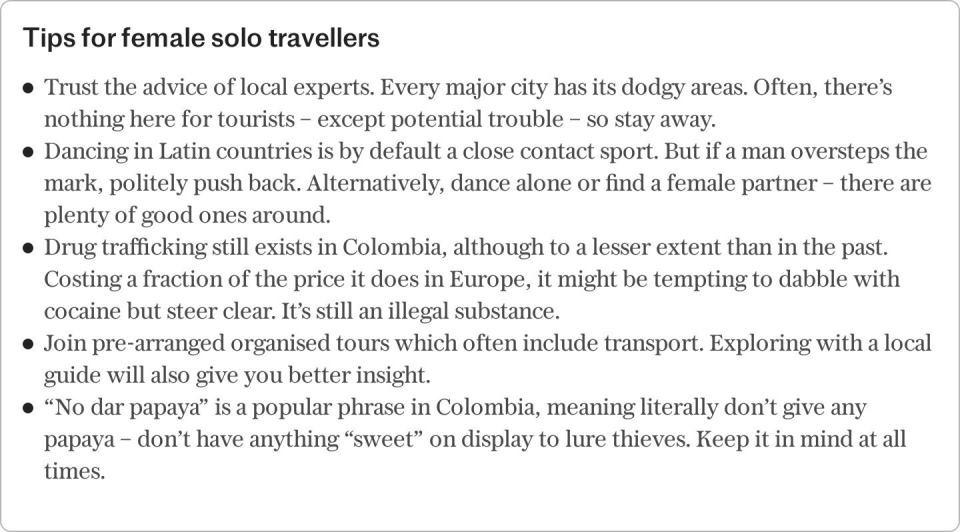How one-time crime capital Colombia turned its fortunes around

Heaving a wooden cart stacked with sheaths of corn and bunches of plantains, 66-year-old Everlides Almanza trundled through the dusty streets of Turbaco as she had done every day for 18 years.
Scrawny chickens pecked at mountains of discarded plastic toys on verandas and scruffy stray dogs lazed in the heat; a familiar scene in many of Colombia’s poorer neighbourhoods.
But a street sign indicated to me this place was very different. “Cuidado, el machismo mata,” it warned. (Careful, machismo kills.)
Everlides was one of 150 displaced women responsible for building Ciudad de Las Mujeres (City of Women) in 2003, a refuge on the outskirts of coastal city Cartagena sheltering victims of gender-based violence forced to leave their homes during the country’s half-century of narco-fuelled conflict.
“We all worked together,” she reminisces. “My daughter was a bricklayer and I cooked in the kitchen; others would look after the babies.”

At that time, Colombia was one of the world’s most dangerous countries, besieged by violent battles between Left-wing guerilla groups, Right-wing paramilitaries, and government forces – all fighting over cocaine.
Bombs were planted in cars, planes and even underneath Botero sculptures. “You could hire a gunman in the 1980s for 20 dollars; the price for a pair of sneakers,” one guide gravely informed me.
Finally, exhausted by years of pointless killings, a peace agreement was brokered between the government and guerilla groups in 2016. As a result, murder rates have dropped to a third of a 30,000 peak in the 1990s, narco traffic – although still present – has significantly dwindled and areas of the country are accessible for the first time in years.
The perception of women is changing too, attracting thousands of solo female travellers – including me. A decade ago, this isn’t a journey I would have done alone. But inspired and intrigued by a group of strong female figures who feature on new tours with Abercrombie & Kent, I was ready to explore without a plus one in tow.
The role of women
“Those years of violence have earned us greater respect,” claimed Marina Martin, another resident of the City of Women who helps members develop enterprises and secure legal rights including ownership of property – a necessity after so many men were killed. But emancipation comes at a price. Putting title deeds into her own name, she admitted, caused her own divorce.
In the past, opportunities for women – who were only granted suffrage in 1954 – were limited to mother, nun, housekeeper or an object of sexual desire. Walking through the banana-yellow archways of Las Bóvedas in Caribbean-splashed city Cartagena, passing trays stacked with coconut sweets and shoe-shiners perched on stalls, I mentally listed the female characters of my favourite Gabriel Garcia Marquez novels. Many fell into these categories.

Shaped by an era of Spanish colonialism largely responsible for cultivating Colombia’s culture of machismo, the enduringly romantic Old Town is superficially locked in a time warp. Trumpets belt salsa melodies from open-air courtyards, dewy-eyed couples watch the sunset from stone ramparts and vendors sell sizzling patacones in the cobbled streets.
But behind the pastel façades, scenes were very different to those I’d witnessed on a trip with my partner several years ago. Buildings have been converted into boutique hotels and designer clothing stores, catering to an influx of tourists – largely from cruises with up to six ships docking in one day. On the plus-side, no-one batted an eyelid as I sipped my overpriced coffee, and I could wander into salsa clubs without the automatic assumption I was there to be picked up.
During a day tour run by local guides, I met Nina, a fellow female solo traveller in her mid-thirties on a month-long trip. “I have avoided some places in the larger cities, but I’ve not run into any problems,” she reassured me.
From Cartagena, I made the one-hour journey to Palenque de San Basilio – the first free slave town of the Americas, given independence in 1713 – to meet some of the 3,500 residents, including the iconic Afro-Colombian palenqueras, famously depicted in the colours of the Colombian flag and carrying bowls of tropical fruit.
Women have always been respected in this self-governing society, responsible for helping slaves escape from Cartagena by communicating pathways through “maps” of braids on their heads. Here, simple concrete houses were covered in bright murals of female drummers.
Inside one building, I found a painting of the first black female vice president of Colombia, Francia Elena Márquez Mina, a single mother and environmental activist who was elected in 2022.

A changing city
To truly appreciate how much Colombia has changed, I travelled to Medellin – once the murder capital of the world and a stomping ground for drug lord Pablo Escobar, a flamboyant character with a fondness for virgins, jacuzzis and hippos.
Rising from a narrow valley between two Andean mountain ranges, where dual carriageways sprout with bamboo, tropical birds flit between office blocks and the metro system is praised for being first class, it hardly seemed the setting for a bloodbath.
But during a walking tour of notorious neighbourhood Comuna 13, once the epicentre of violence, lesbian rapper and guide Catalina vividly recounted some of the horrors that took place. A memorial to her family, all killed when she was eight years old, is inked on her body with a series of tattoos.
“That’s La Escombrera,” she told me, pointing to a bald patch on the opposite hillside, an unmarked grave for hundreds murdered during Operation Orion, a 22-hour killing spree where thousands of residents were caught in a crossfire between army forces and guerillas.
Born from the depths of sadness and frustration, creativity thrives in Comuna 13. Buildings have been reimagined as graffiti-covered bars, hip art galleries and friendly restaurants – mostly run by women.

Zipping down one of several electric escalators installed to better connect the neighbourhood we passed a woman carrying a picket sign denouncing domestic violence. She stopped to high five Catalina and showed me a deep knife wound in her neck. Here, reality is honest and raw.
Previously off limits to outsiders, other areas of the city are also embracing tourism. In Moravia, once quite literally a rubbish dump, Moraviva is a female empowerment project set up by a mother and daughter team.
“Before the garbage would reach 25 metres high,” recalled revered matriarch and local celebrity Marina Aguilar, stood below a mural of her face on the side of a community centre. After realising “garbage is money”, she came up with the idea of recycling rubbish: plastic bottles became building bricks, car tyres were revamped as plant pots and cooking oil was repurposed as soap – one of several activities tourists can try.
Reopened for discovery
Whole regions of the country have become accessible again following the peace agreement. Eager (like many Colombians) to discover these areas, I travelled to San Jose del Guaviare, served by a daily 80-minute flight from capital Bogotá.
On the edge of the Amazon rainforest, staring into the emerald abyss of Chiribiquete National Park – a protected area the size of Denmark only viewable by plane and home to several uncontacted tribes – the small town was a former gateway to coca plantations controlled by guerilla group the FARC. Farmers have since converted to meat and dairy production or tourism, guiding visitors to lakes filled with pink dolphins, rivers that run red with algae blooms and Cerro Azul – the jewel in a forgotten crown – a rock covered with petroglyphs estimated to be 12,000 years old.

Once employed on a coca plantation, our trekking guide Graciela Vergara now belongs to a community association managing visits to the rock paintings. “Financially, coca was a better business,” she told me, as we climbed a spiralling trail knotted with draping vines and coiling roots. “But the situation was too tense.”
Only 120 people per day can trek to Cerro Azul. Visitor numbers are yet to test that limit (currently around 5,000 per year), but, undoubtedly, they will soon. Ochre sketches of handprints, giant sloths, tapirs and humans bowing to hulking creatures are rare connections to a past too easily swallowed by the ravenous jungle.
“Where are the women?” I joked to Graciela, who led me to an image of several figures with swollen bellies.
“They represent creation,” she explained, proudly. “Without them the universe would be nothing.”
But even beyond motherhood, women have a very important role to play in shaping a safer, calmer and more peaceful Colombia.
Capable of constructing cities, I’ve no doubt they have the tools to build a better world, too.




